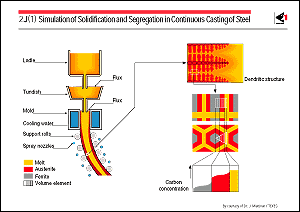After controlling the composition
and temperature, and removing nonmetallic inclusions, the molten
steel is transferred in a ladle and poured into a mold, where
it solidifies to produce semi-finished or finished products.
In the past, the ingot casting-rolling (slabbing, blooming,
or billeting) process was commonly used. In this process, the
molten steel was poured into many cast-iron ingot molds and,
when the solidification was complete, the ingots were taken out,
reheated, and rolled by a slabbing, blooming, or billeting mill.
The continuous casting process has now virtually replaced this
earlier method. In continuous casting, the molten steel in the
ladle is poured into an intermediate vessel(tundish), released
into a hollow water-cooled copper mold, and continuously withdrawn
from the bottom of the mold as a shell begins to form around
the molten metal. The reasons for this change include: (i) the
reheating and slabbing process can be omitted because the cast
strand has a near-net shape similar to that of the semi-finished
product; (ii) the yield is much higher because the continuously
cast strand has only two small end portions, in contrast to the
tops and bottoms which must be cropped from every ingot; (iii)
solute element segregation and nonmetallic inclusions are much
lower; and (iv) advanced technologies have improved the productivity
and surface quality of the cast pieces greatly, to such an extent
that productivity has become compatible with that of the converter
and hot rolling processes, thus providing balanced continuity
among these processes.
The continuous caster allows a cast strand to be withdrawn at
high speed (1.5-2.8 m/min) from the mold in the form of a core
of molten steel encased by a thin solidified shell. This high
withdrawal speed ensures that casting productivity is matched
to that of the converter. As the cast strand descends from the
mold, its surface is cooled by a water spray or water mist, and
the thickness of the shell increases progressively as the material
solidifies. However, the ferrostatic pressure of the molten
steel rises at the same time. The cast strand is therefore supported
by rolls so that the solidified shell does not bulge. If the
solidified shell is deformed due to thermal strains or ferrostatic
pressure, cracks form on both the surface and in the interior
due to the low ductility and low strength of the shell at high
temperatures. An analysis of heat transfer between the molten
steel/solidified shell/mold or spray is necessary to increase
productivity and prevent deformation and cracking. In addition
to this analysis, it is imperative to analyze stress, strain,
and deformation in the solidified shell when it passes through
both the mold and the support rolls. Progress has been made
in the analyses of the heat transfer, elastic-plastic thermal
stress, and creep-behavior of the cast strand by use of the finite
difference and finite element method, and various computational
programs simulating these phenomena have been developed. The
measurement of the dynamic behavior of steel at elevated temperatures
necessary for such computations has also been carried out.
In addition to deformation and cracking, the quality of the cast
strand is impaired by the presence of nonmetallic inclusions
and by the segregation of solute elements. Owing to the reoxidation
of the molten steel by air, entrainment of slag and refractories,
etc., the number of nonmetallic inclusions increases as the steel
moves progressively from the ladle to the tundish to the mold.
To minimize this problem, the flow of molten steel within the
tundish and through the nozzle between the tundish and mold is
carefully controlled to ensure coagulation, flotation, and separation
of nonmetallic inclusions. Progress has been made in research
to evaluate this flow of molten steel by simulation tests with
water models and by mathematical modeling of fluid dynamics based
on numerical solutions to the governing differential equations,
including turbulent forms of the Navier-Stokes equation.
The solubility of solute elements is usually lower in the solid
state than in molten steel. These solute elements are discharged
into the molten steel at the front face of columnar dendrites
of the solidified shell which grows as solidification proceeds.
These solute elements concentrate, resulting in positive segregation.
The segregation of carbon is shown schematically in the right
hand side of the figure. Strong segregation occurs during the
final stage of solidification between the branches of columnar
dendrites and also at the center-thickness of the cast strand.
Solidification theories have been established for the relationship
between the morphology of growing crystals and the temperature
gradient and cooling rate, the segregation of solute elements
near the front of solidifying shell, the rate of solidification
which affects segregation, and the influence of the flow of molten
steel. |
|
 |
 |
 |
|
|